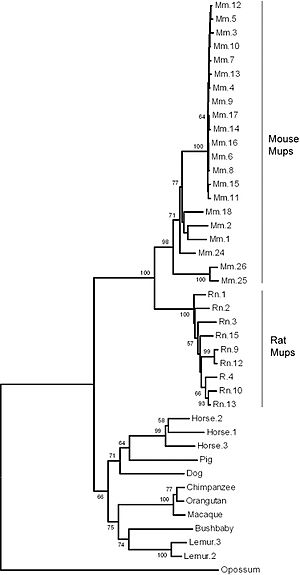Gene family facts for kids
A gene family is a group of genes that are very similar to each other. They all came from one original gene that got copied, or duplicated, over and over again. Because they came from the same original gene, they usually have similar jobs or functions in the body. Think of it like a family of tools – they might all be wrenches, but some are slightly different sizes or shapes, yet they all help tighten or loosen bolts.
The idea that genes can be copied like this is a very old concept in the study of genetics, which is the science of how traits are passed down from parents to children.
Contents
How Gene Families Form
Gene families usually form through a process called gene duplication. Imagine a single gene, which is like a set of instructions for making a specific protein. Sometimes, during the process of cell division, a mistake happens, and a whole gene gets copied an extra time. Now, instead of one copy, there are two!
Over a very long time, these two copies can change slightly. One copy might keep its original job, while the other copy might develop a new, but related, job. This is how new functions can evolve in living things.
Examples of Gene Families
Many important parts of our bodies and other living things are controlled by gene families.
Haemoglobin Genes
One great example in humans is the family of genes that make haemoglobin. Haemoglobin is a protein found in your red blood cells that carries oxygen from your lungs to all parts of your body.
Humans have about ten genes that make different parts, or subunits, of haemoglobin. These genes are found in two main groups, or clusters, on different chromosomes (which are like tiny packages of DNA in your cells). These groups are called the alpha-globin and beta-globin gene clusters. Scientists believe these two clusters came from a single original gene that duplicated about 500 million years ago!
Smell Genes
The biggest known gene family is the one responsible for our sense of smell, called the olfaction genes. Humans have hundreds of these genes, allowing us to detect a huge variety of smells.
Hox Genes
Another very important group is the homeobox genes, often called Hox genes. These genes are like master control switches. They tell different parts of an animal's body where to grow and what shape to take during development. For example, they help decide where legs, wings, or antennae should form on an insect.
Immune System Genes
Your immune system is your body's defense against germs and diseases. It relies on several important gene families.
- Major Histocompatibility Complex (MHC) genes help your immune system recognize friendly cells from invading germs.
- Immunoglobulin genes make antibodies, which are special proteins that can find and stick to harmful invaders like bacteria and viruses, marking them for destruction.
- Toll-like receptors are another family of genes that help mammals (like humans) detect infections. They act like sensors, sounding the alarm when they find something dangerous.
Why Gene Families are Important
Gene families are super important because they allow living things to develop new abilities and adapt to their environments without losing essential functions. When a gene duplicates, one copy can keep doing its original job, while the other copy is free to change and potentially gain a new, useful function. This is a key way that evolution happens.
See also



